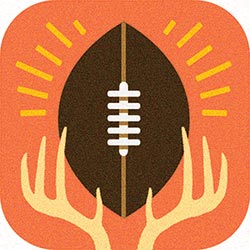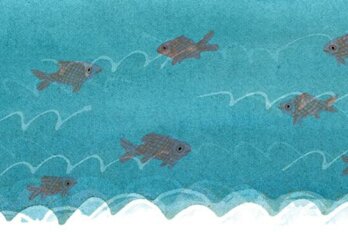Late September, northern Yukon. There is more than a month left in the hunting season, but a snowstorm has wrecked the wheeled plane, and freezing lakes threaten to take the float plane, too. The horses are hungry, and it’s time to trail out.
I am sitting in the back of a seven-passenger Islander, along with the pilot, two hunters, and 450 kilograms of moose meat bound for Dawson City. As the greenest wrangler at Midnight Sun Outfitting, I am taking the chartered flight from base camp at Hart Lake while the others trail the pack horses, crossing two mountain ranges in a four-day ride to the nearest road. Minutes earlier, we flew over the train of horses picking their way through tundra and dwarf birch along old trapping trails, wranglers in front with saddle rolls tied behind them and guns scabbarded beneath their stirrups, waving their hats as we passed.
Brian McLachlan, a geologist, sits behind me. He stares out the window, where the naked, billion-year-old rock of the Ogilvie and Wernecke ranges rises and falls in rusty ridges and folds. Through my headset, I can hear him clearly.
Licence to Heal
What we know about velvet antler
Alex Westgate
This past January, Ray Lewis of the Baltimore Ravens was accused of using deer antler spray as a quick fix for sports injuries. Traditional Chinese medicine has long valued velvet antler—moose, deer, and elk racks in their early stages of growth—for its putative abilities to increase vitality and virility, ease PMS, improve liver and kidney function, and even slow aging. Said to increase testosterone and estrogen levels, the substance also contains insulin-like growth factor-1, which promotes cell regeneration and is therefore banned by the NFL. While producers make claims about its untapped healing potential, no peer-reviewed studies in major North American medical journals have proven its efficacy. Health Canada granted a licence for commercial retail in 2011, but revoked it a year later because the product did not “align…with quality requirements”—suggesting that you can take the bull by the horns (or the antlers, in this case), but what you end up with might just be bull.
—Ainsley Doty
“The mineralization is incredible,” he says.
Together, these ranges make up the bulk of what is known as the Peel Watershed planning region, or simply “the Peel.” Here, in an area nearly the size of New Brunswick, gold, zinc, coal, oil, natural gas, and uranium have been discovered, as well as one of the largest iron ore deposits in North America. So far only antlers, which can be duct-taped to the struts of a small float plane, have been extracted.
I have spent the past month working alongside Jerry Buyck, a veteran hunting guide with an enormous black moustache and a matching Stetson. He believes the next world record antlers will come from these mountains, which is why he returns each fall. These days, he wears a weightlifter’s belt, because his back occasionally spasms after years of lifting moose quarters. Guiding others to the big ones is probably his best chance at glory. “It’s the same thing anyway, guiding,” he explained one evening as we dried our socks by the wood stove, carefully out of earshot from our client. “You just let someone else pull the trigger.”
We both knew this wasn’t exactly true: only one person takes home the trophy. In certain circles, a world record on the wall is as sought after as a Monet. Midnight Sun’s hunters pay upwards of $20,000 for the chance to get one. Many clients, like McLachlan, make this money in the Alberta oil patch, and a few have spent years saving up for their big chance. But others—like the Exxon executive who tipped Buyck $2,000, or the ones who fly in on private jets—make more in a day than a guide will in an entire season.
In this company, a good guide learns to stay away from certain topics. When, later that evening, I asked him casually, as if I had never read a Yukon newspaper, what he thought of roads and pipelines in his hunting grounds, he went poker faced.
“I don’t talk politics,” he said.
This season, tensions are running high. A Yukon Party majority government has apparently abandoned the land use plan developed with the four affected First Nations, including Buyck’s own, Na-Cho Nyak Dun. The government insists that the Final Recommended Plan, which would put 80 percent of the Peel off limits to new mining claims, is not in the interest of the majority of Yukoners—including, presumably, the 23 percent who belong to First Nations. It proposes alternative land use concepts that redefine “wilderness area” to allow exploration and access roads.
The Peel discussion has been bubbling for nearly twenty years, and big game outfitting is a stakeholder in the region’s wilderness condition. Moose, caribou, and Dall sheep, the main game species in the Peel, require huge swaths of habitat. Industrial development would also erode the pristine character that makes the Peel such a desirable hunting destination.
Outfitting is a big money-maker in the Peel, generating an estimated $2.5 million annually, but it offers jobs few locals are trained to do, so help often parachutes in the way I did, as seasonal labour from the Western provinces. A few years ago, Buyck helped to run a mentoring program, taking six Na-Cho Nyak Dun youths into the mountains and teaching them how to wrangle and guide. None of them ended up sticking it out for more than a season.
“Too much work,” he maintained. Given the choice, most would rather take a job running heavy equipment than trailing horses. After four saddle-sore weeks, I see his point.
It takes more than just $160 a day to convince someone to spend a season, let alone fifteen, cut off from the world. Buyck, like so many guides and hunters at Midnight Sun, is smitten with the land itself. Even the obsession with world record antlers (big, pointy things that they are) is about something bigger than status or personal glory. It is also an impulse to preserve and marvel at a piece of this extraordinary place, even if that piece is just a big, pointy thing that hangs on the wall.
On the ground in Dawson, Buyck and I meet up just off Front Street. It is late in the afternoon. His moustache is trimmed, and he is wearing a black leather jacket to match his hat. There is a poker tournament in town tonight.
A half-hour before registration closes, we unload the last of the antlers into the back of a tandem-axle trailer. The pile of moose antlers, sheep horns, bearskins, and caribou skulls reaches from floor to ceiling, an eerie monument of spikes and peeling velvet. We only have time for a glimpse before Buyck closes the door and secures it with a heavy padlock. We are back in town now, and one can never be too careful with antlers.
This appeared in the November 2013 issue.





